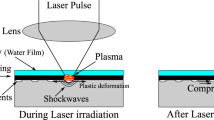Abstract
By using finite element analysis, we proposed an applicable finite element method of laser shock peening (LSP) and discussed various parameters, such as solution time, stability limit, dynamic yield stress, peak pressure, pressure pulse duration, laser spot size, and multiple LSP. The effects of parameters related to the finite element simulation of the LSP process on the residual stresses of 35CD4 30HRC steel alloy are discussed. Parametric sensitivity analyses were performed to establish the optimum processing variables of the LSP process. In addition, we evaluated the effects of initial residual stress, such as welding-induced residual stress field.
Similar content being viewed by others
References
K. Ding and L. Ye, Laser shock peening Performance and process simulation, CRC Press (2006) 47–118.
K. Ding and L. Ye, Simulation of multiple laser shock peening of a 35CD4 steel alloy, J. of Materials Processing Technology, 178 (2006) 162–169.
J. E. Masse and G. Barreau, Laser generation of stress waves in metal, Surface and Coating Technology, 70 (1995) 231–234.
ABAQUS Version 6. 7 and 6.9, User’s manual, Dassault Systemes (2008).
W. Braisted and R. Brockman, Finite element simulation of laser shock peening, Int. J. of Fatigue, 21 (1999) 719–724.
X. Ling, W. Peng and G. Ma, Influence of Laser Peening Parameters on Residual Stress Field of 304 Stainless Steel, J. of Pressure Vessel Technology, 130(021120) (2008) 1–8.
J. H. Kim, Y. J. Kim, H. Y. Bae, C. Y. Oh, J. S. Kim and J. S. Kim, Numerical simulation of two-sided laser shock peening using finite element method, Korean Society of Pressure Vessel and Piping Spring Conference (2011) 127–128.
P. Peyre and R. Fabbro, Laser shock processing: a review of the physics and applications, Optical and Quantum Electronics, 27 (1995) 1213–1229.
C. Yang, P. D. Hodgson, Q. Liu and L. Ye, Geometrical effects on residual stresses in 7050-T7451 aluminum alloy rods subject to laser shock peening, J. of Material Processing Technology, 201 (2008) 303–309.
P. Ballard, J. Fournier, R. Fabbro and J. Frelat, Residual stresses induced by laser-shocks, J. de Physique IV, 1 (1991) 487–581.
Y. Hu and Z. Yao, Numerical simulation and experimentation of overlapping laser shock processing with symmetry cell, Int. J. of Machine Tools & Manufacture, 48 (2008) 152–162.
B. W. Bang, S. K. Son, J. M. Kim and C. D. Cho, Residual Stress Prediction in LSP Surface Treatment by Using FEM, KSME-A, 33(8) (2009) 776–772.
Y. Lei, N. P. O’Dowd and G. A. Webster, Fracture mechanics analysis of a crack in a residual stress field, Int. J. of Fracture, 106 (2000) 195–216.
Author information
Authors and Affiliations
Corresponding author
Additional information
Recommended by Associate Editor Jeong Sam Han
Ju Hee Kim is an assistant professor of the Department of Mechanical Engineering, Korea Military Academy, Seoul, Korea. His main research interests are residual stress analysis for welding and LSP simulation.
Rights and permissions
About this article
Cite this article
Kim, J.H., Kim, Y.J. & Kim, J.S. Effects of simulation parameters on residual stresses for laser shock peening finite element analysis. J Mech Sci Technol 27, 2025–2034 (2013). https://doi.org/10.1007/s12206-012-1263-0
Received:
Revised:
Accepted:
Published:
Issue Date:
DOI: https://doi.org/10.1007/s12206-012-1263-0



